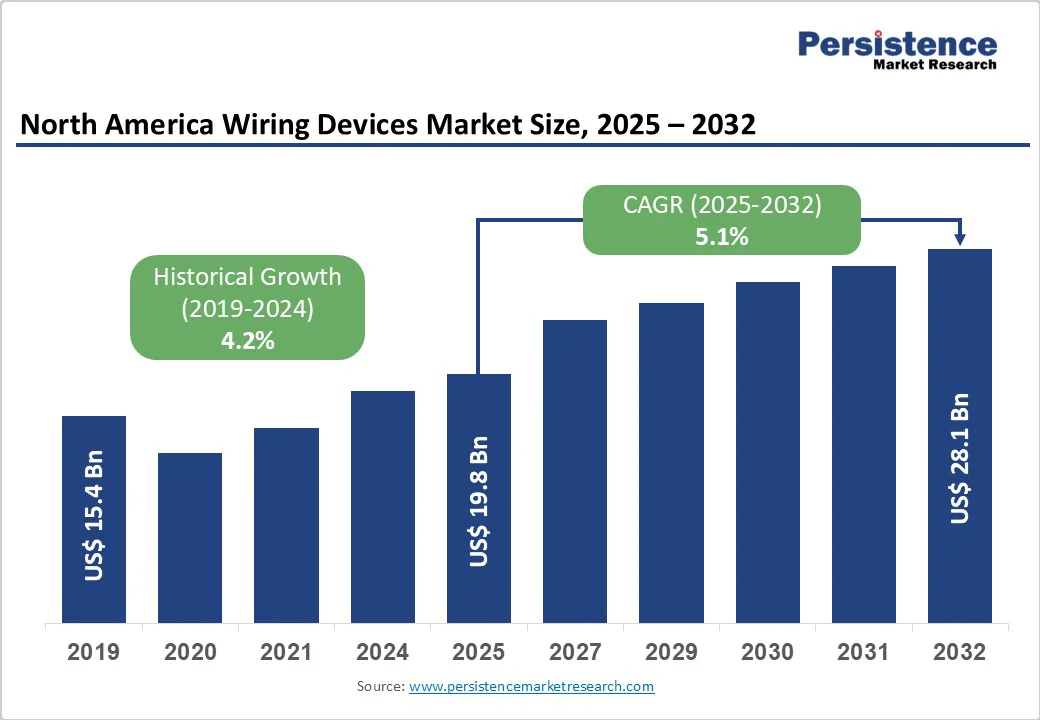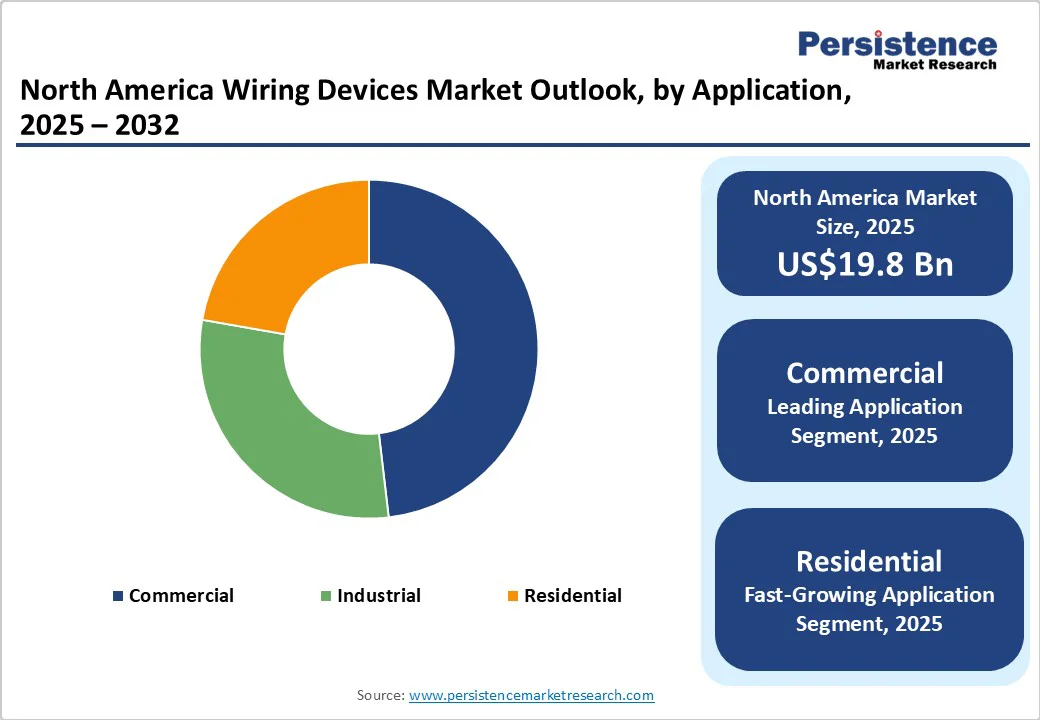ID: PMRREP34965| 184 Pages | 13 Oct 2025 | Format: PDF, Excel, PPT* | Semiconductor Electronics

The North America wiring devices market size is likely to value US$19.8 Bn in 2025 to US$28.1 Bn by 2032, growing at a CAGR of 5.1% during the forecast period from 2025 to 2032.
The market growth is underpinned by accelerating smart home automation adoption, extensive residential renovation activities, and robust commercial infrastructure development across the region. Regulatory standards promoting electrical safety and energy efficiency further boost market expansion. The growing construction of data centers, healthcare facilities, and industrial plants continues to support market demand.
| North America Wiring Devices Market Attribute | Key Insights |
|---|---|
| Wiring Devices Market Size (2025E) | US$19.8 Bn |
| Market Value Forecast (2032F) | US$28.1 Bn |
| Projected Growth (CAGR 2025 to 2032) | 5.1% |
| Historical Market Growth (CAGR 2019 to 2024) | 4.2% |

There is unprecedented investment in electrical infrastructure, with over US$36.9 billion in public, private, and non-federal investments committed to advancing a more resilient grid system. The Grid Deployment Office has selected more than 1,121 projects for US$14.5 billion in federal competitive funding, with expected impacts that will improve grid resilience for 90 million homes and businesses across the country.
This massive infrastructure modernization initiative requires extensive deployment of advanced wiring devices, including circuit protection equipment, smart switches, and intelligent connection systems. The aging electrical infrastructure, combined with increasing electricity demand from data centers and the adoption of electric vehicles, necessitates comprehensive upgrades that directly benefit wiring device manufacturers.
The growing emphasis on energy efficiency in North America is driving demand for advanced wiring devices. U.S. regulations, including the 2024 IECC, ASHRAE 90.1-2022, and California’s 2025 Title 24, mandate occupancy sensors, daylight harvesting, and automated lighting, boosting adoption of smart devices such as Hubbell’s H-MOSS sensors.
DOE estimates that compliance with ASHRAE 90.1-2022 can reduce commercial building site energy by ~9.8%, source energy by 9.4%, and energy costs by 8.9%. EIA projects U.S. power demand rising from 4,097 billion kWh in 2024 to 4,305 billion kWh by 2026. These trends, supported by DOE programs, are accelerating investments in energy-efficient wiring systems with monitoring, demand management, and automation capabilities.
The high upfront cost of smart wiring devices, particularly for retrofit installations, remains a significant barrier to adoption. Complex installations often require professional expertise and additional infrastructure, such as network hubs, with compatibility issues sometimes necessitating further system upgrades.
Smart switches, outlets, and dimmers, which offer energy efficiency, automation, and remote control, come at a premium, making full home outfitting in the U.S. cost around $2-$7 per square foot. These expenses, combined with platform-specific requirements, deter cost-sensitive consumers and small businesses from upgrading traditional wiring to connected solutions.
Industries and households are increasingly adopting wireless solutions, such as Bluetooth, Wi-Fi, and ZigBee, thereby reducing their reliance on traditional wired infrastructure, particularly in consumer electronics, automotive, and building automation. IoT-enabled products are driving this shift, with wireless sensors replacing complex wiring in automation, energy management, and security systems.
North America leads the wireless connectivity market, which is projected to remain the largest region by 2027, fueled by the growing adoption of mobile and wearable technologies. This trend pressures the wiring devices market to innovate or face potential obsolescence.
The rising demand for high-speed connectivity, driven by AI, ML, and cloud computing, is creating significant opportunities for wiring devices in North America. The expansion of data centers, including those in Tier 2 markets such as Green Bay, Wisconsin, is driving the adoption of high-performance fiber optic solutions, such as high-fiber-count cables, to handle the growing data flows.
The rise of edge computing is further accelerating regional data center development, increasing the need for advanced wiring devices to support next-generation data transmission. According to the Electric Power Research Institute (EPRI), the electricity consumption of U.S. data centers is expected to grow from 4% of total load in 2023 to 9% by 2030, highlighting the scale of infrastructure expansion.
Rapid EV adoption and the expansion of green building initiatives are creating significant opportunities. By early 2025, the U.S. had over 207,000 public EV charging ports across more than 75,000 stations, including 55,000 or more DC fast chargers and 167,000 or more Level 2 chargers. Meanwhile, California alone accounted for 178,000 or more chargers and 1.3 million registered EVs, driving demand for high-power, reliable wiring solutions.
At the same time, sustainable construction practices and LEED certifications, with over 105,000 commercial projects certified, are fueling demand for energy-efficient switches, outlets, and advanced circuit breakers. Canada’s goal to cut building emissions by 40% by 2030 further highlights the growth potential for eco-friendly wiring devices.
Current-carrying devices are expected to account for more than 49.2% share in 2025, due to the growing need for safe and reliable electrical distribution. The rise of high-power applications, including EV charging, smart buildings, and data centers, requires robust circuit protection and efficient current management. These devices ensure uninterrupted power flow, prevent overloads, and meet stringent safety standards, making them essential in modern electrical infrastructure.
Circuit protection devices are expected to grow at a CAGR of 6.2% driven by heightened safety awareness and regulatory requirements. This segment encompasses fuses and circuit breakers, which are essential for preventing electrical overloads, short circuits, and equipment damage.
Advanced circuit protection technologies, including smart breakers with remote monitoring capabilities and predictive maintenance features, are gaining traction in both residential and commercial applications. The shift towards energy-efficient and IoT-enabled systems increases the need for precise current management, making circuit protection devices essential in modern electrical installations.
The commercial segment is expected to account for over 40.1% share in 2025 due to the need for reliable, safe, and efficient electrical infrastructure in offices, retail spaces, hospitals, and other commercial buildings. These facilities require robust wiring solutions to support energy-efficient lighting, smart building systems, HVAC controls, and high-speed data networks.
The growing emphasis on safety, compliance with electrical codes, and integration of IoT-enabled devices further drives demand for sophisticated wiring devices. Advanced lighting controls and integrated building management platforms increase the need for wiring solutions that can support complex operational requirements.
The residential segment is expected to grow at the highest rate due to increasing demand for smart homes, energy-efficient solutions, and safe electrical infrastructure. Rising adoption of home automation systems and connected lighting drives the need for advanced switches, sockets, and circuit protection devices.
The expansion of new housing projects and renovations further fuels demand. According to the American Home Shield Corporation survey, 93% of Americans own at least one smart home device, and 42% report that the majority of their home devices are now "smart".
Consumers are increasingly prioritizing safety, compliance with electrical codes, and convenience, which supports growth in modern residential wiring solutions. The 2024 National Electrical Code (NEC) mandates that all residential services require Type 1 or Type 2 Surge Protective Devices (SPDs), applicable to new builds and panel upgrades.

The United States dominates the North America wiring devices market, holding more than 76% share in 2025 and generating significant revenue from its robust construction sector and technology adoption patterns. The U.S. wiring devices market is projected to reach over US$24.1 billion by 2032, driven by extensive smart home integration, commercial infrastructure development, and industrial modernization initiatives. The rapid growth of data center facilities, with hyperscale operations requiring sophisticated electrical infrastructure capable of supporting high-density computing environments.
The residential renovation market remains particularly strong, with kitchen and bathroom projects accounting for the majority of home improvement spending and driving consistent demand for updated wiring devices. According to the U.S. Census Bureau, in July 2025, residential construction spending was estimated at a seasonally adjusted annual rate of US$886.5 billion, 0.1% above the revised June estimate of US$885.9 billion.
Canada’s market expansion is supported by government smart city initiatives, urban development projects, and clean energy transition policies. The sector benefits from federal backing for grid modernization and renewable energy integration, as outlined in the Clean Electricity Regulations finalized in December 2024. In current carrying devices, Canada is expected to hold over 40% share in 2025.
Provincial utilities in Canada are heavily investing in grid infrastructure to support electrification goals, with a focus on integrating distributed energy resources and enhancing system resilience. The regulatory framework encourages energy-efficient electrical equipment through incentives and building codes that favor advanced wiring solutions. Ontario and British Columbia are leading market development with substantial infrastructure investments and progressive energy policies.
Investment opportunities are emerging in smart grid technologies, energy storage integration, and cold-climate electrical solutions tailored to Canada’s environmental conditions. Government research support and collaboration between utilities, technology providers, and academic institutions are strengthening the innovation ecosystem. The growing adoption of zero-emission vehicles (ZEVs), highlighted in Natural Resources Canada’s “Green Fleet Best Practices Guide” (July 2025), is driving demand for specialized wiring devices for EV charging infrastructure.
Companies are emphasizing innovation by integrating advanced technologies such as smart and connected wiring devices. With the rise of IoT-enabled homes and offices, companies are offering products such as smart switches, dimmers, and outlets that integrate seamlessly with voice assistants and home automation systems.
Continuous investment in R&D helps manufacturers stay ahead, enhancing product performance, user experience, and energy efficiency. To strengthen market presence, manufacturers are forming partnerships with builders, electricians, and distributors.
The North America market is projected to be valued at US$19.8 Bn in 2025.
The growing demand for safe, energy-efficient electrical installations is a key driver of the market.
The market is poised to witness a CAGR of 5.1% from 2025 to 2032.
Rising adoption of smart homes and buildings, which creates demand for advanced, connected, and IoT-enabled wiring solutions, creates strong growth opportunities.
Schneider Electric, TE Connectivity, Legrand, Leviton Manufacturing Co., Panasonic Corporation, Lutron Electronics Co., Inc., ABB, Hubbell Incorporated are among the leading key players.
| Report Attribute | Details |
|---|---|
| Historical Data/Actuals | 2019 - 2024 |
| Forecast Period | 2025 - 2032 |
| Market Analysis | Value: US$ Bn/Mn, Volume: As Applicable |
| Geographical Coverage |
|
| Segmental Coverage |
|
| Competitive Analysis |
|
| Report Highlights |
|
By Product
By Application
By Country
Delivery Timelines
For more information on this report and its delivery timelines please get in touch with our sales team.
About Author